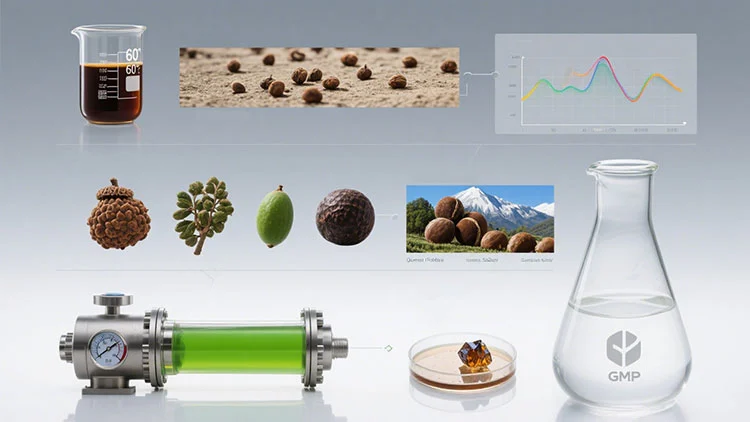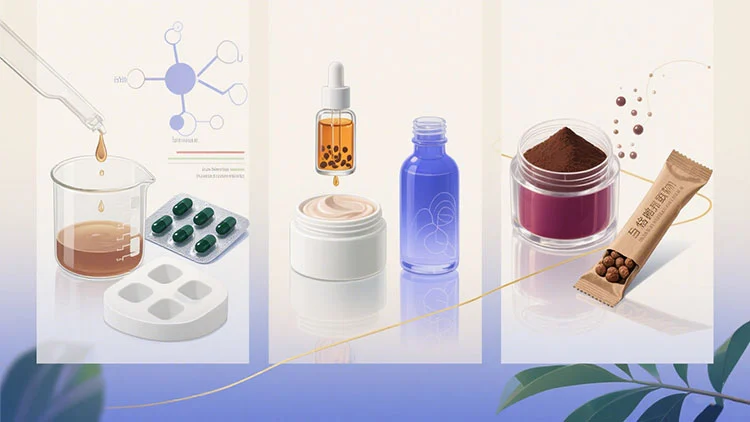Gallnut Extract Composition: Hydrolysable Tannins & Gallic Acid
Gallnut extract, derived from the nutrient-rich excrescences formed on oak trees by certain insect species, has garnered significant attention in the fields of natural medicine and functional ingredients. The extract's composition is primarily characterized by two key components: hydrolysable tannins and gallic acid. These bioactive compounds are responsible for the extract's diverse range of beneficial properties, making it a valuable resource in various industries. Understanding the intricate composition of gallnut extract is crucial for harnessing its full potential and developing innovative applications in pharmaceuticals, cosmetics, and functional foods. This blog post delves into the complex world of gallnut extract, exploring its primary constituents, their properties, and the myriad ways they can be utilized to enhance human health and well-being.
Antioxidant and antimicrobial properties of gallnut-derived constituents
Free radical scavenging activity
Gallnut extract is renowned for its potent antioxidant properties, primarily attributed to its high content of hydrolysable tannins and gallic acid. These compounds exhibit exceptional free radical scavenging activity, effectively neutralizing harmful reactive oxygen species (ROS) that can damage cellular structures and contribute to oxidative stress. Studies have shown that gallnut extract demonstrates superior antioxidant capacity compared to many synthetic antioxidants, making it a promising natural alternative for various applications. The polyphenolic structure of tannins and gallic acid allows them to donate electrons to unstable free radicals, thereby stabilizing them and preventing further oxidative damage. This powerful antioxidant activity of gallnut extract has significant implications for its use in both preventive and therapeutic contexts, particularly in addressing conditions associated with oxidative stress.
Inhibition of microbial growth
In addition to its antioxidant properties, gallnut extract exhibits remarkable antimicrobial activity against a wide range of pathogenic microorganisms. The hydrolysable tannins and gallic acid present in the extract have been shown to effectively inhibit the growth of various bacteria, fungi, and viruses. This antimicrobial action is attributed to multiple mechanisms, including the disruption of microbial cell membranes, inhibition of essential enzymes, and interference with microbial metabolism. Research has demonstrated the efficacy of gallnut extract against both gram-positive and gram-negative bacteria, including antibiotic-resistant strains. Furthermore, the extract's antifungal properties make it a valuable tool in combating fungal infections and food spoilage. The broad-spectrum antimicrobial activity of gallnut extract opens up numerous possibilities for its application in natural preservatives, antimicrobial coatings, and topical treatments for various infections.
Synergistic effects with other bioactive compounds
One of the most intriguing aspects of gallnut extract is its potential for synergistic interactions with other bioactive compounds. When combined with certain phytochemicals or synthetic agents, the antioxidant and antimicrobial properties of gallnut extract can be significantly enhanced. For instance, studies have shown that combining gallnut extract with vitamin C or other plant-derived antioxidants can result in a more potent antioxidant effect than either compound alone. Similarly, the antimicrobial activity of gallnut extract can be augmented when used in conjunction with certain essential oils or conventional antibiotics, potentially offering a solution to combat antibiotic resistance. This synergistic potential not only amplifies the benefits of gallnut extract but also opens up new avenues for developing more effective and multifaceted natural formulations for various health and wellness applications.

Variations in composition based on extraction methods and source quality
Impact of extraction techniques on tannin content
The extraction method employed plays a crucial role in determining the final composition and quality of gallnut extract. Various techniques, including solvent extraction, supercritical fluid extraction, and ultrasound-assisted extraction, can significantly influence the yield and profile of hydrolysable tannins and gallic acid obtained from gallnuts. For instance, traditional solvent extraction using ethanol or water typically results in a high yield of tannins but may also extract unwanted impurities. In contrast, supercritical CO2 extraction offers a more selective approach, yielding a purer extract with a higher concentration of bioactive compounds. The choice of extraction solvent, temperature, and duration can all affect the ratio of different tannin fractions in the final product. Moreover, recent advancements in green extraction technologies have shown promise in improving the sustainability and efficiency of gallnut extract production while maintaining or even enhancing the desired bioactive profile.
Influence of gallnut source and harvesting conditions
The quality and composition of gallnut extract are heavily influenced by the source of the gallnuts and the conditions under which they are harvested. Factors such as the species of oak tree, geographical location, climate, and time of harvest can all impact the concentration and types of tannins and gallic acid present in the gallnuts. For example, gallnuts harvested from Quercus infectoria (commonly known as Aleppo oak) are often considered superior due to their high tannin content. Additionally, the maturity of the gallnuts at the time of harvest plays a significant role in their chemical composition. Immature gallnuts typically contain higher levels of hydrolysable tannins, while more mature gallnuts may have a higher proportion of gallic acid. Environmental stressors, such as drought or pest infestation, can also alter the phytochemical profile of gallnuts, potentially affecting the quality of the resulting extract. Consequently, careful selection and quality control of gallnut sources are essential for ensuring consistent and high-quality extracts.
Standardization and quality control measures
Given the variability in gallnut extract composition due to extraction methods and source quality, standardization and rigorous quality control measures are paramount. Establishing standardized protocols for gallnut extract production helps ensure consistency in the final product's chemical profile and biological activity. This typically involves setting specific parameters for tannin and gallic acid content, as well as monitoring for potential contaminants. Advanced analytical techniques such as high-performance liquid chromatography (HPLC) and mass spectrometry are commonly employed to characterize and quantify the bioactive components in gallnut extracts. Additionally, bioassays measuring antioxidant capacity and antimicrobial activity are often used to verify the extract's potency. Implementing good manufacturing practices (GMP) and adhering to international quality standards further contribute to the production of high-quality, reliable gallnut extracts. These standardization efforts not only enhance the extract's efficacy and safety but also facilitate its integration into various industrial applications.

Applications in pharmaceuticals, cosmetics, and functional foodsTherapeutic potential in pharmaceutical formulations
The pharmaceutical industry has shown growing interest in gallnut extract due to its diverse therapeutic potential. The high concentration of hydrolysable tannins and gallic acid in gallnut extract makes it a promising candidate for various medicinal applications. In pharmaceutical formulations, gallnut extract has been explored for its anti-inflammatory, antidiabetic, and anticancer properties. Studies have demonstrated its efficacy in reducing inflammation in conditions such as arthritis and inflammatory bowel diseases. The extract's ability to modulate glucose metabolism has sparked interest in its potential as a natural adjunct therapy for diabetes management. Furthermore, the antioxidant and antiproliferative effects of gallnut extract components have shown promise in cancer prevention and treatment strategies. Ongoing research is also investigating the extract's potential in wound healing, liver protection, and cardiovascular health. As the pharmaceutical industry continues to seek natural alternatives with fewer side effects, gallnut extract stands out as a versatile and potent option for developing novel therapeutic formulations.
Incorporation into cosmetic and skincare products
The cosmetic and skincare industry has embraced gallnut extract as a valuable ingredient due to its antioxidant, antimicrobial, and astringent properties. The extract's ability to neutralize free radicals makes it an excellent addition to anti-aging formulations, helping to combat oxidative stress-induced skin damage and premature aging. Its antimicrobial properties are particularly beneficial in acne-fighting products, as it can help control the growth of acne-causing bacteria. The astringent nature of gallnut extract also makes it useful in toners and pore-refining products, helping to tighten and tone the skin. Additionally, the extract's potential to inhibit tyrosinase activity has led to its inclusion in skin-brightening and hyperpigmentation treatments. Many natural and organic skincare brands are incorporating gallnut extract into their product lines, capitalizing on its multifaceted benefits and appeal to consumers seeking plant-based, effective skincare solutions. As the demand for natural and sustainable beauty products continues to grow, gallnut extract is likely to play an increasingly prominent role in cosmetic formulations.
Development of functional foods and nutraceuticals
The functional food and nutraceutical sectors are increasingly turning to gallnut extract as a potent natural ingredient to enhance the health benefits of their products. The extract's strong antioxidant properties make it an attractive addition to functional beverages, dietary supplements, and fortified foods aimed at boosting overall health and well-being. Its potential to support digestive health, owing to its antimicrobial and anti-inflammatory properties, has led to its inclusion in probiotic formulations and gut health supplements. Some companies are exploring the use of gallnut extract in weight management products, capitalizing on preliminary studies suggesting its potential to influence lipid metabolism and fat absorption. The extract's ability to modulate blood glucose levels also makes it a candidate for inclusion in diabetic-friendly food products. As consumers become more health-conscious and seek natural alternatives to synthetic additives, gallnut extract offers food manufacturers a versatile, plant-based option to enhance the nutritional profile and functionality of their products. However, careful consideration must be given to taste, stability, and bioavailability when incorporating gallnut extract into food and beverage formulations.
Conclusion
Gallnut extract, with its rich composition of hydrolysable tannins and gallic acid, offers a myriad of applications across pharmaceuticals, cosmetics, and functional foods. Its potent antioxidant and antimicrobial properties, coupled with its therapeutic potential, make it a valuable natural ingredient. As research continues to unveil new benefits and applications, gallnut extract is poised to play an increasingly significant role in developing innovative, health-promoting products. The key to maximizing its potential lies in careful sourcing, standardized extraction methods, and ongoing scientific investigation to fully harness the power of this remarkable natural resource.
At Shaanxi SCIGROUND Biotechnology Co., Ltd., we are committed to harnessing the power of natural plant extracts like gallnut extract to develop innovative and effective products for various industries. Our state-of-the-art facilities and experienced team ensure the highest quality standards in our extracts. We offer a wide range of plant-based ingredients, including gallnut extract, to meet the diverse needs of our clients in the health food, pharmaceutical, and cosmetic sectors. For more information on our products and services, please contact us at info@scigroundbio.com. Let us help you unlock the potential of nature's bounty for your next groundbreaking product.
References
1. Zhang, J., Li, L., Kim, S. H., Hagerman, A. E., & Lü, J. (2009). Anti-cancer, anti-diabetic and other pharmacologic and biological activities of penta-galloyl-glucose. Pharmaceutical research, 26(9), 2066-2080.
2. Aguilar-Galvez, A., Noratto, G., Chambi, F., Debaste, F., & Campos, D. (2014). Potential of tara (Caesalpinia spinosa) gallotannins and hydrolyzates as natural antibacterial compounds. Food chemistry, 156, 301-304.
3. Tian, F., Li, B., Ji, B., Yang, J., Zhang, G., Chen, Y., & Luo, Y. (2009). Antioxidant and antimicrobial activities of consecutive extracts from Galla chinensis: The polarity affects the bioactivities. Food chemistry, 113(1), 173-179.
4. Abdelwahed, A., Bouhlel, I., Skandrani, I., Valenti, K., Kadri, M., Guiraud, P., ... & Chekir-Ghedira, L. (2007). Study of antimutagenic and antioxidant activities of Gallic acid and 1, 2, 3, 4, 6-pentagalloylglucose from Pistacia lentiscus: Confirmation by microarray expression profiling. Chemico-biological interactions, 165(1), 1-13.
5. Choi, H. J., Song, J. H., Bhatt, L. R., & Baek, S. H. (2010). Anti-human rhinovirus activity of gallic acid possessing antioxidant capacity. Phytotherapy Research, 24(9), 1292-1296.
6. Arapitsas, P. (2012). Hydrolyzable tannin analysis in food. Food chemistry, 135(3), 1708-1717.